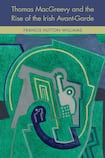
There is something perplexing about the fate of the poet, art curator and first World War veteran Kerry-born Thomas MacGreevy because as with several other poets of his generation, while his poems survive in various anthologies and studies of 20th century Irish poetry, they are generally unavailable in book form.
Since the 1991 edition of his Collected Poems, edited by Susan Schreibman, who also edited an important critical reappraisal, The Life and Work of Thomas MacGreevy in 2013, MacGreevy’s poems, like much of his published prose, can only be accessed through the library or second-hand. And yet his name and influence over 50 years since his death in 1967, remains front and central when the conditions, lifestyles and histories of a number of Irish poets, artists and intellectuals, loosely described as modernists, are brought into critical focus.
MacGreevy’s well-known friendship with James Joyce and Samuel Beckett are just some of the varied and complex range of his contacts with British and European writers and artists whose literary and imaginative achievements redefined what poetry, fiction, and visual art was all about. Recognition for his lifelong connections with France, in particular, were reflected in various important honours which he received as director of the National Gallery but throughout his life he was at the centre of a network which included such powerful intellectual figures and leading writers as T S Eliot and his knowledge of what was happening within the Irish artistic scene is matched by his promotion of important Irish artists of his time including Jack Yeats and Mainie Jellett, whose Green Abstract provides the wondrous cover for this book.
It is impossible to read the extensive, intimate and enduring correspondence with Beckett without recognising the trust fondness with which he was held by his younger (and questioning) contemporary, not to mention the wider circle of poets, some of whom emerged from UCD in the 1930s, including Denis Devlin and Brian Coffey, poet and publisher of Europa Press, George Reavey, Ethna MacCarthy and Sheila Wingfield, among many others.
While the Irish State was in the early decades of its new independent life, these poets and intellectuals, along with many other painters and musicians, were seeking out new lives for themselves in London or Paris, Barcelona or New York. Others again including activists such as Leslie Daiken and Charles Donnelly were busy with numerous artistic and political projects, establishing theatrical groups as well as left-wing political groupings and responding to the big issues of their day. There really was nothing insular about their Ireland. How and why they managed to develop elsewhere is a history all to itself.
Handsomely produced
If Frank Hutton-Williams’s succinct, timely and coherent monograph on MacGreevy and the Irish avant-garde does nothing else but underline this important historical reality check, then it has advanced our learning and underscored the need for a substantial social and literary rethink of the decades between the Spanish Civil War and post “Neutrality” Ireland.
In five clearly-defined and well-stocked chapters, Hutton-Williams has presented a valuable portrait not only of MacGreevy’s development – first as a poet in the aftermath of the Irish revolution, followed by his transformative experiences in Paris and London, his critical importance in redefining the nature of Irish art and artists before concluding with his legacy as director of the National Gallery. Handsomely produced with full colour plates and bringing together the available scholarship and archival material, the insights, based upon the work of many scholars and editors such as Michael Smith whose Lace Curtain and New Writers Press did so much to maintain an interest in the MacGreevy era, Hutton-Williams, a teacher of English at Dulwich College, and former student at Cambridge, Trinity College (where he first encountered MacGreevy) and Oxford, has produced a first- class study. He is particularly good at connecting the social and cultural moment to the poetic or artistic act, even when things might be extenuated to breaking point, as indeed they are in the case of Samuel Beckett’s early poetry and literary journalism. Remarking on Beckett’s article of 1934 Recent Irish Poetry as a “devastating caricature of literary society in Dublin”, the fact that in a year’s time “618 books and 11 periodicals had been listed as banned by the Free State Register” it is probably little wonder that some of the poetry which came out of this period – MacGreevy’s Poems, Beckett’s Echo’s Bones and Other Precipitates and Devlin’s Intercessions – expressed a kind of militant syntactical anger in defiance of the more traditional airs and graces of leading poets such as FR Higgins; the same in relation to art and artists. But it would be a misreading to think that these men and women constituted a self-conscious “group” as MacGreevy more than anything else shows, his commitment to Ireland and Irish art as a national concept was as a passionate European. It would take Patrick Kavanagh and his energy to emerge out of this period and produce poems, etched with a remarkably deceiving simplicity of voice and form, and to take the new Ireland, its vernacular language and popular traditions into the 20th century; Thomas MacGreevy really was, as Hutton-Williams makes clear, by some time, in the advance party.
Gerald Dawe’s poetry collection, The Last Peacock, was recently published by The Gallery Press. The Sound of the Shuttle: Essays on Cultural Belonging & Northern Protestantism is due next year from Irish Academic Press












